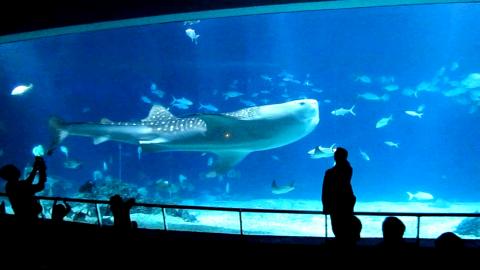The Environment and Animal Society of Taiwan (EAST) and several other environmental groups yesterday said that the National Museum of Marine Biology and Aquarium kept whale sharks in small tanks that caused their health to deteriorate.
The group urged the aquarium to release the last remaining whale shark and not to bring in new ones.
According to EAST director Chen Yu-min (陳玉敏), the aquarium in Pingtung County has held three whale sharks — a species that has been listed on “Appendix II” of the Convention on International Trade in Endangered Species of Wild Fauna and Flora and labeled “vulnerable” by the International Union for Conservation of Nature — in captivity since April 2004, in the name of education and marine research.

Photo courtesy of the Environment and Animal Society of Taiwan
The groups’ investigation suggested that one whale shark died of poor health in 2007, another was secretly released into the ocean without undergoing rehabilitation or tagging for follow-up research the same year and the remaining 6m-long whale shark was being kept in a small tank, Chen said.
Showing a video clip and photographs of the remaining whale shark at a press conference in Taipei yesterday, Chen said that it had scars on its tail from hitting the tank’s walls and reefs in the tank because the tank was too small.
Citing data from whale shark tag release research conducted by Chuang Shou-cheng (莊守正), an associate professor at the National Taiwan Ocean University’s Department of Environmental Biology and Fisheries Science, the groups said that whale sharks often stay in deep waters — about 5m to 10m below the sea surface, but sometimes submerge to 80m below sea level, and that they can migrate up to 34km a day.
Keeping the whale shark in its current tank, which is 33m long, 22m wide and about 8m to 12m in depth, is like keeping it in a jail cell, the groups said, adding that the video showed the whale shark swimming in the tank in the same circling direction.
It took the whale shark about 50 to 80 seconds to swim a circle in the tank, which meant that it would swim about 360 to 576 circles just in the eight hours that the aquarium was open daily, the groups said.
Lai Wei-jen (賴威任), office director of the Kuroshio Ocean Education Foundation, said whale sharks have a life span of about 70 to 100 years in the ocean, but data from an aquarium in Okinawa, Japan, showed that 16 whale sharks kept in captivity during the period from 1980 to 1998 lived for an average of only 16 months.
Lee Chan-rong (李展榮), an official at the aquarium, said the aquarium has proposed to tag release the remaining whale shark after it introduces a new small whale shark into the tank, allowing the bigger whale shark to teach the new whale shark for a while.
The groups urged the government not to approve the proposal to introduce any whale sharks, and to ask the aquarium to tag release the remaining whale shark as soon as possible.

US climber Alex Honnold is to attempt to scale Taipei 101 without a rope and harness in a live Netflix special on Jan. 24, the streaming platform announced on Wednesday. Accounting for the time difference, the two-hour broadcast of Honnold’s climb, called Skyscraper Live, is to air on Jan. 23 in the US, Netflix said in a statement. Honnold, 40, was the first person ever to free solo climb the 900m El Capitan rock formation in Yosemite National Park — a feat that was recorded and later made into the 2018 documentary film Free Solo. Netflix previewed Skyscraper Live in October, after videos

NUMBERS IMBALANCE: More than 4 million Taiwanese have visited China this year, while only about half a million Chinese have visited here Beijing has yet to respond to Taiwan’s requests for negotiation over matters related to the recovery of cross-strait tourism, the Tourism Administration said yesterday. Taiwan’s tourism authority issued the statement after Chinese-language daily the China Times reported yesterday that the government’s policy of banning group tours to China does not stop Taiwanese from visiting the country. As of October, more than 4.2 million had traveled to China this year, exceeding last year. Beijing estimated the number of Taiwanese tourists in China could reach 4.5 million this year. By contrast, only 500,000 Chinese tourists are expected in Taiwan, the report said. The report

Temperatures are forecast to drop steadily as a continental cold air mass moves across Taiwan, with some areas also likely to see heavy rainfall, the Central Weather Administration (CWA) said. From today through early tomorrow, a cold air mass would keep temperatures low across central and northern Taiwan, and the eastern half of Taiwan proper, with isolated brief showers forecast along Keelung’s north coast, Taipei and New Taipei City’s mountainous areas and eastern Taiwan, it said. Lows of 11°C to 15°C are forecast in central and northern Taiwan, Yilan County, and the outlying Kinmen and Lienchiang (Matsu) counties, and 14°C to 17°C

STEERING FAILURE: The first boat of its class is experiencing teething issues as it readies for acceptance by the navy, according to a recent story about rudder failure The Hai Kun (海鯤), the nation’s first locally built submarine, allegedly suffered a total failure of stern hydraulic systems during the second round of sea acceptance trials on June 26, and sailors were forced to manually operate the X-rudder to turn the submarine and return to port, news Web site Mirror Daily reported yesterday. The report said that tugboats following the Hai Kun assisted the submarine in avoiding collisions with other ships due to the X-rudder malfunctioning. At the time of the report, the submarine had completed its trials and was scheduled to begin diving and surfacing tests in shallow areas. The X-rudder,